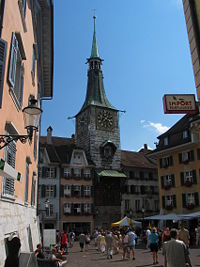Solothurn
| Solothurn | ||||||||||
|---|---|---|---|---|---|---|---|---|---|---|
|
||||||||||
| Population | 15,086 (December 2006[update]) | |||||||||
| - Density | 2,398 /km² (6,212 /sq.mi.) | |||||||||
| Area | 6.29 km² (2.4 sq mi) | |||||||||
| Elevation | 430 m (1,411 ft) | |||||||||
| Postal code | 4500 | |||||||||
| SFOS number | 2601 | |||||||||
| Mayor | Kurt Fluri (as of 2008) FDP/PRD | |||||||||
| Surrounded by (view map) |
Bellach, Biberist, Feldbrunnen-Sankt Niklaus, Langendorf, Rüttenen, Zuchwil | |||||||||
| Twin towns | Heilbronn (Germany), Kraków (Poland), Le Landeron (Switzerland) | |||||||||
| Website | www.stadt-solothurn.ch | |||||||||
![Solothurn [zoom] (Switzerland)](/2009-wikipedia_en_wp1-0.7_2009-05/I/265px_Karte_Schweiz.png) Solothurn [zoom]
|
||||||||||
|
|||||||||||||||||||||||||||||||
The city of Solothurn (German: Solothurn, French: Soleure, Italian: Soletta) is the capital of the Canton of Solothurn in Switzerland. The city also comprises the only municipality of the district of the same name.
Contents |
Geography
Solothurn is on the Aare river, at the foot of the Jura mountains.
History
This Celtic settlement was renewed around AD 14–37 by the Roman emperor Claudius, and became a Roman stronghold (castrum) under the name of Salodurum. Its strategical importance lay in the position at the approach to the Rhine from southeast.
In the Middle Ages the settlement grew around the remains of the Roman fortress and the religious house of St. Ursen, dedicated to Ursus of Solothurn, founded in the 8th century. In 1127, it was acquired by the dukes of Zähringen, and became a free imperial city in 1218 when that dynasty extinguished. After the alliance with Berne in 1295, it became part of the Swiss Confederation. In 1382 the Habsburgs attacked the city, involving Solothurn in the Battle of Sempach. By the treaty of two years later, the Habsburgs renounced all claims to the territory of the city. The latter was expanded by acquisition of neighbouring lands in the 15th century, roughly up to the today's canton area.
In 1481, it obtained full membership in the Swiss Confederation, and in 1530–1792 it was the seat of the French ambassador to the Swiss. On October 15, 1817, Tadeusz Kościuszko, the national hero of Poland and United States died in Solothurn and was initially interred at the local cemetery.
In 1828 Solothurn became the seat of the Bishop of Basel.
Rock band Krokus was formed in Solothurn in 1974.
Architecture

The city calls itself Switzerland's largest Baroque City.
The old town was built between 1530 and 1792 and shows an architectural combination of Italian Grandezza, French style and Swiss ideas. In 2004, it had a population of 15,137.
In 1980, Solothurn was awarded the Wakker Prize for the development and preservation of its architectural heritage.
Main sights
- Besenval Palace
- Cathedral St. Ursus (1762–73). It was begun by Gaetano Matteo Pisoni and completed by Paolo Antonio Pisoni. The interior has stuccoes by Francesco Pozzi and canvasses by Domenico Corvi.
- Church of the Jesuits (Jesuitenkirche, 1680–89)
- Clock tower (Zeitglockenturm, 12th century)
- Gate of Basel
- Gate of Bienne
- Landhaus
- Museum of the Old Arsenal (1609–14), housing the most ancient collection of armor in Europe.
- Old town
- The Verena Gorge and the Hermitage
- Waldegg Castle
- Weissenstein mountain
The number 11
Solothurn has a special affinity to the number eleven.
The Canton of Solothurn was the eleventh to become part of the Swiss Confederation. There are eleven churches and chapels, as well as eleven historical fountains and eleven towers. The St. Ursus cathedral has eleven altars and eleven bells, and the stairs in front of the cathedral have levels between every eleven steps.
A local brewery has named itself Öufi, which is Swiss German for eleven, and produces a beer with the same name.

Sister cities
 Heilbronn, Baden-Württemberg, Germany, since 1981
Heilbronn, Baden-Württemberg, Germany, since 1981 Kraków, Lesser Poland, Poland, since 1990
Kraków, Lesser Poland, Poland, since 1990 Le Landeron, Berne, Switzerland, since 2003
Le Landeron, Berne, Switzerland, since 2003
See also
- Solothurner Literaturpreis
External links
- Official site (German)
- Every Shop in Solothurn on Smagoo
- Solothurn tourist office (English)
- Virtual Citytour (German)
|
|||||
|
|||||||
